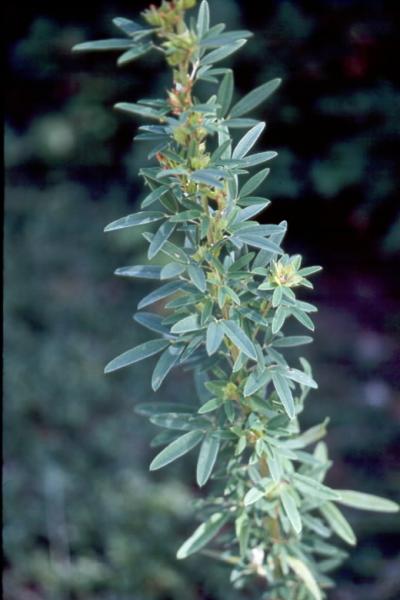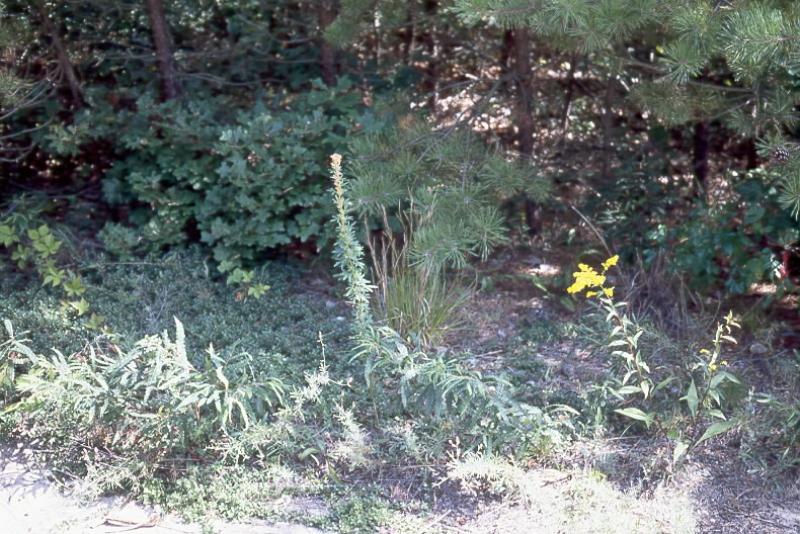Stuve's Bush Clover
Lespedeza stuevei Nutt.
- Class
- Dicotyledoneae (Dicots)
- Family
- Fabaceae (Pea Family)
- State Protection
- Threatened
Listed as Threatened by New York State: likely to become Endangered in the foreseeable future. For animals, taking, importation, transportation, or possession is prohibited, except under license or permit. For plants, removal or damage without the consent of the landowner is prohibited.
- Federal Protection
- Not Listed
- State Conservation Status Rank
- S2
Imperiled in New York - Very vulnerable to disappearing from New York due to rarity or other factors; typically 6 to 20 populations or locations in New York, very few individuals, very restricted range, few remaining acres (or miles of stream), and/or steep declines.
- Global Conservation Status Rank
- G4?
Apparently Secure globally (most likely) - Conservation status is uncertain, but most likely uncommon in the world but not rare; usually widespread, but may be rare in some parts of its range; possibly some cause for long-term concern due to declines or other factors. More information is needed to assign a firm conservation status.
Summary
Did you know?
This plant was named for 19th-century Prussian botanist and pharmacist Wilhelm Stuwe (Haddock 2010).
State Ranking Justification
There are nine existing populations but only three of them are large. There are 25 historical occurrences, mostly in Nassau and Suffolk counties on Long Island but many of these have probably been extirpated.
Conservation and Management
Threats
The succession of the open grassland habitat to more woody plants is a threat.
Conservation Strategies and Management Practices
The open habitat needs to be maintained in an open canopied state but the plants should not be disturbed during the growing season.
Research Needs
There are no research needs known at this time.
Habitat
Habitat
In New York it grows mainly in disturbed openings dominated by grasses and wildflowers within pitch pine scrub oak barrens, pitch pine oak woods and coastal oak hickory woods. It can often be along trails or roadsides within these woodlands (New York Natural Heritage Program 2012). Dry upland woods and barrens (Gleason and Cronquist 1991).
Associated Ecological Communities
- Pitch pine-heath barrens
(guide)
A shrub-savanna community that occurs on well-drained, sandy or rocky soils. The most abundant tree is pitch pine and the shrublayer is dominated by heath shrubs.
- Pitch pine-oak forest
(guide)
A mixed forest that typically occurs on well-drained, sandy soils of glacial outwash plains or moraines; it also occurs on thin, rocky soils of ridgetops. The dominant trees are pitch pine mixed with one or more of the following oaks: scarlet oak, white oak, red oak, or black oak.
- Pitch pine-oak-heath woodland
(guide)
A pine barrens community that occurs on well-drained, infertile, sandy soils. The structure of this community is intermediate between a shrub-savanna and a woodland. Pitch pine and white oak are the most abundant trees.
- Pitch pine-scrub oak barrens
(guide)
A shrub-savanna community that occurs on well-drained, sandy soils that have developed on sand dunes, glacial till, and outwash plains.
Associated Species
- Agrostis tenuis
- Ambrosia artemisiifolia (common ragweed)
- Andropogon gerardii
- Apocynum cannabinum (Indian-hemp)
- Artemisia vulgaris (mugwort)
- Asclepias tuberosa (butterfly-weed)
- Aureolaria virginica (downy false fox-glove)
- Baptisia tinctoria (wild-indigo)
- Carex pensylvanica (Pennsylvania sedge)
- Centaurea
- Chamaecrista fasciculata
- Chrysopsis mariana (Maryland golden-aster)
- Comptonia peregrina (sweet-fern)
- Daucus carota (wild carrot)
- Deschampsia flexuosa
- Desmodium ciliare (hairy small-leaved tick-trefoil)
- Desmodium marilandicum (smooth small-leaved tick-trefoil)
- Dichanthelium clandestinum (deer-tongue rosette grass)
- Eupatorium hyssopifolium (hyssop-leaved thoroughwort)
- Eurybia spectabilis (showy-aster)
- Juncus tenuis (path rush)
- Lespedeza
- Lespedeza capitata (round-headed bush-clover)
- Lespedeza hirta
- Lespedeza intermedia
- Lespedeza procumbens (trailing bush-clover)
- Lespedeza virginica (slender bush-clover)
- Myrica pensylvanica
- Pinus rigida (pitch pine)
- Pityopsis falcata (sickle-leaved golden-aster)
- Plantago aristata (long-bracted plantain)
- Plantago lanceolata (English plantain)
- Polygala nuttallii (Nuttall's milkwort)
- Prunus serotina
- Quercus alba (white oak)
- Quercus coccinea (scarlet oak)
- Quercus ilicifolia (scrub oak, bear oak)
- Quercus velutina (black oak)
- Rhus copallinum
- Solidago juncea (early goldenrod)
- Solidago nemoralis
- Solidago odora (sweet goldenrod)
- Symphyotrichum pilosum var. pringlei (Pringle's-aster)
- Tephrosia virginiana (goat's-rue)
- Tridens flavus
Range
New York State Distribution
The largest number of populations occur on Long Island and Staten Island where it is currently known from Staten Island and Suffolk County on Long Island. There are historical records north along the Hudson Valley to Washington County and one record in the Southern Tier in Tioga County. There is also an unconfirmed report from Erie County.
Global Distribution
This is a plant of the southeastern and central US. It extends to the states of the Northeast where it is rare except in the southern New England states of Massachusetts, Rhode Island, and Connecticut.
Identification Comments
General Description
Velvety bush-clover is a perennial that grows erect as either a simple stem or a stem branched towards the top. It grows to about 1 meter tall and the stem is covered with soft hairs that stand out. The leaves are on short petioles and have 3 elliptic leaflets. The largest leaflets are 1.5-3.5 cm long, hairy above and densely velvety below. The purple flowers are in dense racemes in the upper axles of the leaves on peduncles that are shorter than the leaves. The flowers are 6-8 mm long. The upper two sepals-lobes are not joined together or only slightly joined at the base. The fruit is densely hairy (Gleason and Cronquist 1991).
Identifying Characteristics
Distinguishing characteristics: leaves wooly or velvety with spreading hairs, beneath; calyx lobes 1.7-3.5 mm, the 2 uppermost connate less than half their length and not extending to the middle of the fruit, fruit velvety. Best life stage for ID: in fruit. Characteristics needed to ID: leaves and fruit.
Best Life Stage for Proper Identification
The best time to identify this plant is when it is in flower or fruit.
Similar Species
Lespedeza virginica and Lespedeza intermedia are closely related and much more common but the undersides of their leaves are not densely velvety but only with long hairs that are appressed to the leaves. The upper two sepals-lobes are joined together at least half of their length. Their fruits are somewhat hairy but not densely hairy (Gleason and Cronquist 1991).
Best Time to See
The plants flower beginning in August. Fruits develop in September and are visible through October.
- Flowering
- Fruiting
The time of year you would expect to find Stuve's Bush Clover flowering and fruiting in New York.
Stuve's Bush Clover Images
Taxonomy
Stuve's Bush Clover
Lespedeza stuevei Nutt.
- Kingdom Plantae
- Phylum Anthophyta
- Class Dicotyledoneae
(Dicots)
- Order Fabales
- Family Fabaceae (Pea Family)
- Order Fabales
- Class Dicotyledoneae
(Dicots)
- Phylum Anthophyta
Additional Common Names
- Bush-clover
- Lespedeza
- Velvety Bush Clover
- Velvety Lespedeza
Synonyms
- Lespedeza stuvei auct. non
Additional Resources
Best Identification Reference
Gleason, Henry A. and A. Cronquist. 1991. Manual of Vascular Plants of Northeastern United States and Adjacent Canada. The New York Botanical Garden, Bronx, New York. 910 pp.
Other References
Clemants, Steven and Carol Gracie. 2006. Wildflowers in the Field and Forest. A Field Guide to the Northeastern United States. Oxford University Press, New York, NY. 445 pp.
Clewell, A. F. 1966a. Native North American species of Lespedeza (Leguminosae). Rhodora 68(775):359-405.
Fernald, M.L. 1950. Gray's manual of botany. 8th edition. D. Van Nostrand, New York. 1632 pp.
Holmgren, Noel. 1998. The Illustrated Companion to Gleason and Cronquist's Manual. Illustrations of the Vascular Plants of Northeastern United States and Adjacent Canada. The New York Botanical Garden, Bronx, New York.
Isely, D. 1990. Vascular flora of the southeastern United States. Vol. 3, Part 2. Leguminosae (Fabaceae). Univ. North Carolina Press, Chapel Hill. 258 pp.
Mitchell, Richard S. and Gordon C. Tucker. 1997. Revised Checklist of New York State Plants. Contributions to a Flora of New York State. Checklist IV. Bulletin No. 490. New York State Museum. Albany, NY. 400 pp.
New York Natural Heritage Program. 2024. New York Natural Heritage Program Databases. Albany, NY.
Weldy, T. and D. Werier. 2010. New York flora atlas. [S.M. Landry, K.N. Campbell, and L.D. Mabe (original application development), Florida Center for Community Design and Research http://www.fccdr.usf.edu/. University of South Florida http://www.usf.edu/]. New York Flora Association http://newyork.plantatlas.usf.edu/, Albany, New York
Links
About This Guide
This guide was authored by: Stephen M. Young
Information for this guide was last updated on: September 6, 2012
Please cite this page as:
New York Natural Heritage Program. 2024.
Online Conservation Guide for
Lespedeza stuevei.
Available from: https://guides.nynhp.org/velvety-bush-clover/.
Accessed July 27, 2024.

